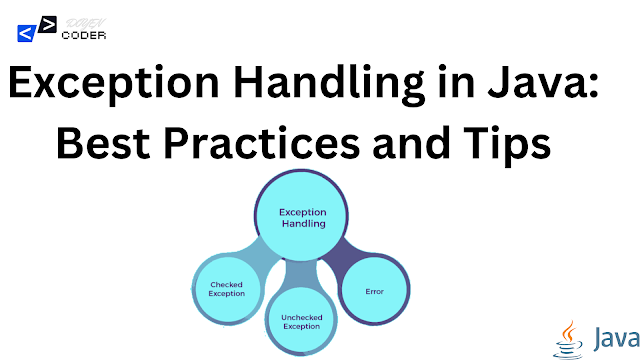Exception Handling in Java: Best Practices and Tips
1. What is Exception Handling?
Exception handling in Java is a mechanism to handle runtime errors, ensuring that the normal flow of the application is not disrupted. Java provides a powerful exception-handling framework to manage these errors efficiently.
2. Types of Exceptions in Java
In Java, exceptions are categorized into three types:
- Checked Exceptions: These are exceptions that are checked at compile-time (e.g., `IOException`, `SQLException`).
- Unchecked Exceptions: These occur at runtime and include exceptions like `NullPointerException`, `ArrayIndexOutOfBoundsException`.
- Errors: Represent serious problems that are not expected to be caught by the application (e.g., `OutOfMemoryError`).
3. Basic Exception Handling with try-catch
The `try-catch` block is used to catch exceptions that might occur during the execution of the code. The `try` block contains the code that might throw an exception, and the `catch` block handles the exception.
Example:
try {
int result = 10 / 0; // This will throw ArithmeticException
} catch (ArithmeticException e) {
System.out.println("Cannot divide by zero!");
}
4. Using finally Block
The `finally` block is used to execute code regardless of whether an exception is thrown or not. It is often used for cleanup activities like closing files or releasing resources.
Example:
try {
int[] arr = new int[5];
System.out.println(arr[7]); // ArrayIndexOutOfBoundsException
} catch (ArrayIndexOutOfBoundsException e) {
System.out.println("Array index is out of bounds!");
} finally {
System.out.println("This will always execute.");
}
5. Throwing Exceptions
You can explicitly throw an exception in Java using the `throw` keyword. This is typically used when you want to indicate that something went wrong during the execution of your program.
Example:
public class Main {
static void checkAge(int age) {
if (age < 18) {
throw new IllegalArgumentException("Age must be 18 or older");
}
System.out.println("You are eligible to vote!");
}
public static void main(String[] args) {
checkAge(15); // This will throw IllegalArgumentException
}
}
6. Best Practices for Exception Handling
Here are some best practices when handling exceptions in Java:
- Use Specific Exceptions: Always catch specific exceptions rather than a generic `Exception`. This makes your code more robust.
- Avoid Empty Catch Blocks: Don't swallow exceptions by having empty catch blocks. At the very least, log the exception.
- Never Catch Throwable: Avoid catching `Throwable` or `Error`, as these indicate serious issues that the application should not attempt to handle.
- Use finally for Cleanup: Use the `finally` block to close resources like file streams, database connections, etc.
- Document Exceptions: Use JavaDoc comments to document the exceptions your methods can throw.
7. Custom Exceptions
You can create your own exception class by extending the `Exception` class. This is useful when you want to handle application-specific errors.
Example:
class InvalidAgeException extends Exception {
public InvalidAgeException(String message) {
super(message);
}
}
public class Main {
static void validate(int age) throws InvalidAgeException {
if (age < 18) {
throw new InvalidAgeException("Age is not valid for voting");
} else {
System.out.println("Welcome to vote!");
}
}
public static void main(String[] args) {
try {
validate(16);
} catch (InvalidAgeException e) {
System.out.println("Exception caught: " + e.getMessage());
}
}
}
Key Points Covered:
- What is Exception Handling: Introduction to the purpose of exception handling in Java.
- Types of Exceptions: Checked, unchecked, and errors.
- Basic Exception Handling: Example of try-catch block.
- Finally Block: Example of how finally ensures execution.
- Throwing Exceptions: How to throw exceptions explicitly.
- Best Practices: Tips on writing good exception-handling code.
- Custom Exceptions: How to create and use a custom exception.



